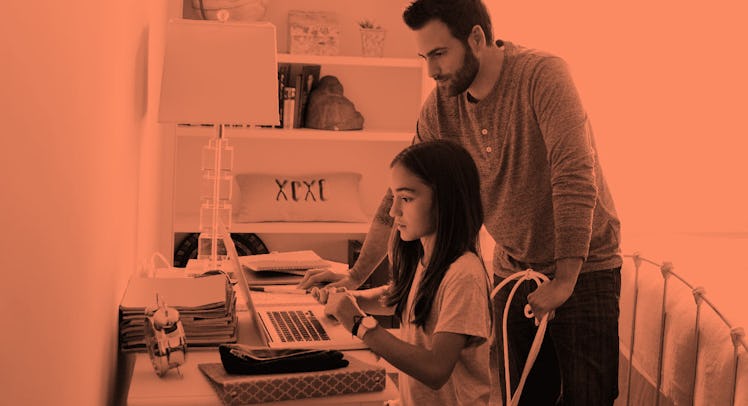How to Safeguard Your Child Against Cyberbullying
And prevent them from becoming a cyberbully in their own right.

Cyberbullying has become a significant issue for young people learning to navigate a life that is increasingly online. Like bullying that occurs face-to-face, cyberbullying can have serious effects on the physical and mental health of victims.
Cyberbullying in isolation is very uncommon. Of young people who report being bullied, a clear majority have said it occurred face-to-face (71.5 percent). Over a quarter experienced bullying face-to-face and online (27.4 percent), and a very small percentage experienced cyberbullying only (1.1 percent).
READ MORE: The Fatherly Guide to Bullying
It’s important we don’t focus on cyberbullying alone, and instead address the fundamentals of bullying more widely. Essential to tackling this complex issue is understanding which kids bully and why they do it.
Which Kids Bully?
All kids are capable of bullying. A study over seven years showed a majority of kids bully others at some point during their time at school. Many stop as they grow older, but just as many continue. Those who consistently bully their peers over the long-term are learning to use their power to control and harm others. This pattern of behavior can continue into adulthood.
This article was originally published on The Conversation. Read the original article by Hannah Thomas, The University of Queensland and James Graham Scott, The University of Queensland.
To complicate things further, it’s common for those who perpetrate bullying to also be victims of bullying. Our research suggests this is the case for at least 50 percent of young people who perpetrate bullying. Young people who are victimized and perpetrate bullying are at the greatest risk of mental health problems.
RELATED: Everything You Need To Know About Internet Safety For Kids
Why Do Kids Bully?
Bullying can be a successful way to achieve high social status or peer acceptance. It’s most effective for achieving social dominance when used in combination with “pro-social” behavior such as helping, sharing, and cooperating with others.
A young person’s pro-social behavior helps to reconcile their bullying behavior once their dominance is established. This group of individuals are socially skilled and generally have high levels of popularity among their peers.
There is also a second group of individuals who perpetrate bullying, but they are less successful in raising their social status. Their aggressive behavior towards their peers is often impulsive and over-reactive, and they tend to report being victims of bullying themselves. These are the individuals who are most likely to have behavioral and mental health problems.
Kids who bully their peers are not all the same. These two groups need different responses by parents and teachers in order to address the bullying behavior. The first group need to be redirected to achieve their desired social status among their peers using only pro-social behavior. The second group needs support to help them establish and maintain positive relationships with their peers.
ALSO: A 15-Year-Old Girl Developed An App That Might End Cyberbullying
What Can Parents Do?
Digital technology is now a central part of most young peoples’ lives. Parents need to show patience and curiosity about their child’s online behavior.
Parents must be clear that bullying is always unacceptable. But, they should also try to see the situation through their child’s eyes, as young people may not have the maturity to fully consider the consequences of their actions.
Children will often try to justify their behavior, so a parent’s role is to help them develop empathy for others.
This requires ongoing discussions and encouraging the child to reflect on how their behavior makes others feel. It is unhelpful for the child to be shamed or to ban access to the technology. This kind of response prevents the child from opportunities to learn responsible online behavior.
MORE: How to Spot the Signs a Kid is Being Bullied or Becoming a Bully
But, parents must take charge in setting the conditions of using technology. This includes monitoring its use until a time when the young person shows they can manage their online behavior responsibly.
If the behavior continues, then it may be necessary to involve health professionals and the child’s school. It’s better for parents to be proactive in taking steps to manage the behavior rather than waiting for other systems to step in (education or police).
Online interactions are complex. Young people need parents to support them in making good choices about how they conduct themselves online. Strengthening parents’ skills in effectively managing issues of cyberbullying is an important part of the solution.
This article was originally published on